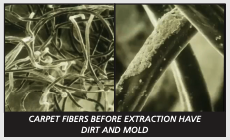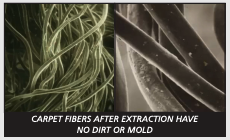Cleaning Carpets and IAQ with Hot-Water Extraction
Over the years we have been doing indoor air quality (IAQ) consulting, we have run into many weird and unusual situations. But sometimes the problems we encounter have simple causes and simple solutions.
We have responded to complaints about odors, noise, airborne irritants, and even coworkers (psychosocial). But the most common complaint involves people reacting to irritant dust levels. Now, dust is a general term that may involve particles, fibers, dirt, or even mold. But we don’t know what the issue is when we arrive.
We routinely sample airborne particles on every IAQ survey we perform. And the insights that this specialized air sampling provides help us identify the source of many of the complaints we hear.
We recently surveyed a high-end buildout completed in a Class A building in response to general IAQ complaints. We immediately noticed high particle levels in the complaint area during our review. Since the offices weren’t occupied during our visit, we didn’t have the complainants to interview. Instead, the receptionist and staff supervisor were there. After gathering our data and finding high particle counts in three individual offices and a neighboring conference room, we talked with the supervisor. He mentioned that the complaints started shortly after some minor remodeling was done. A more detailed discussion indicated that the remodeling contractor didn’t use plastic to isolate the construction area during the work. This means that the particles and dust from construction activities (cutting, sanding, etc.) settled in the carpeting. Then, every time someone walked into their office or a group met in the conference room, dust would become airborne and irritate the occupants. The complaints included sneezing and coughing as well as eye, nose, and throat irritation.
The Research
We attended a recent presentation at the 2022 Healthy Building Conference discussing this issue. It involved researchers who visited a Class A building that received regular and consistent custodial services. Nightly dusting and vacuuming were the norms for the three floors studied. And the training provided to the custodial staff was also reviewed. That training was equal to the standard of care provided for Class A office buildings across the United States. The researchers looked at particles, mold, and bacteria in the airborne tests performed. The analytical results showed occasional Penicillium and Aspergillus molds and gram-negative bacteria spikes. They also saw increased particulate matter when the carpeting was disturbed, thus demonstrating that the indoor environment is an ecosystem with normal fluctuations. Yes, even in a building receiving outstanding custodial care. The researchers noted that “with proper attention to source management through routine cleaning and immediate attention to unexpected occurrences, those fluctuations can be controlled.” Their research recommended establishing the following indoor environmental management guidelines:
- Clean for health first, appearance second
- Maximize the extraction of pollutants
- Minimize chemical, particle, and moisture residues
- Properly dispose of cleaning waste
- Provide for safety, including minimizing human exposure to pollutants
The Recommendations
Many of our clients know that we recommend using hot-water extraction methods to clean carpeted surfaces. The researchers agreed with our recommendations and suggested using high-detergent cleaners with low VOCs (volatile organic compounds). Next, they recommended no bleach-based products and cleansers with a low solvent content. Finally, they directed that “no or minimal fragranced products” be used in cleaning and treating the carpet materials.
So, how clean will carpeting be after using hot-water extraction methods? Surprisingly, the researchers also collected tape-lift samples from carpets both before and after the hotwater extraction. Remember that the before cleaning samples were carpeting that received regular custodial attention and HEPA (high efficient particle air) filter vacuuming. Those samples were collected and sent to a laboratory for scanning electron microscopic analysis. The photos taken of the carpet before and after the cleaning (top, right) really tell the story.

 As the “before” photos show, the carpet fibers are twisted and matted and show many whitecolored areas. The white-colored reflection is the buildup of dirt and mold on the surface of individual carpet fibers. Routine vacuuming won’t have much impact on contaminants like this. Instead, the researchers dictated cleaning of the carpet using hot-water extraction with active-air drying, feeling that this would be the only way to remove the buildup and hopefully straighten the carpet fibers shown in the before photos. The cleaning results (shown in the after photos) include straightening carpet fibers and removing the buildup of dirt, dust, debris, and mold from individual fibers.
As the “before” photos show, the carpet fibers are twisted and matted and show many whitecolored areas. The white-colored reflection is the buildup of dirt and mold on the surface of individual carpet fibers. Routine vacuuming won’t have much impact on contaminants like this. Instead, the researchers dictated cleaning of the carpet using hot-water extraction with active-air drying, feeling that this would be the only way to remove the buildup and hopefully straighten the carpet fibers shown in the before photos. The cleaning results (shown in the after photos) include straightening carpet fibers and removing the buildup of dirt, dust, debris, and mold from individual fibers.
Finally, let me remind you that once the carpet is cleaned using hot-water extraction, the most effective way to dry it is with active air movement using floor fans in a conditioned environment. Although many carpet cleaning and custodial firms want to rely on the building’s HVAC systems to dry the carpet, we disagree! Using the HVAC system’s air supply exclusively can leave the carpet surfaces wet for too long, which can encourage mold to begin growing. And growing microscopic colonies of mold on your carpet can create an entirely different IAQ concern that no one wants to encounter.
We have learned that the initial response to many IAQ complaints involves cleaning carpeting to remove many years of dust, dirt, and debris. Cleaning carpeting using the proper methods reduces the burden on the occupant’s health and has a psychological effect as well. And that alone buys you weeks or even months of cleaner indoor air and happier building occupants.
If you’d like to know if airborne particles are creating IAQ problems in your building, give us a call. We can compare the complaint areas to non-complaint areas and let you know what the data says.
